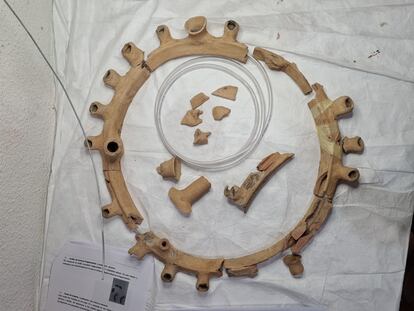The Roman Empire’s largest oil lamp
The Elda Museum in Alicante is exhibiting a newly restored chandelier-style lantern from the 1st century A.D., which features 32 points of light


Lucius Eros lived during the reigns of emperors Augustus and Tiberius during the 1st century A.D. in an Iberian-Roman town called Elo, in what is now the municipality of Elda in Alicante (Valencia region). He was a potter and signed each of his ceramic oil lamps, engraving his name on the mold he used to make them. Now, archaeologists have restored one of these artifacts, found in pieces, and have declared it to be the largest of its kind from the Roman period.
Accommodating 32 points of light and reaching half a meter in diameter, it was hung from the ceilings of large buildings. In addition to the chandelier-style oil lamp, which is now on display at the Elda Museum, four molds for other types of lamps have been recovered from the Iberian-Roman archeological site of Elo-Monastil, where Lucius had his workshop and three kilns.
Between 2009 and 2010, more fragments of at least two of these large lamps were recovered, which also featured ducts through which oil was introduced
The Romans inherited the technique of making circular ceramic objects to illuminate interiors from the Greeks and Phoenicians. They were fueled by oil and lit with a small wick or piece of fabric. By the 3rd century B.C., their use had spread throughout the Mediterranean, leading the Romans to open workshops to manufacture them wherever they ruled.
In 1989, Antonio M. Poveda, professor of Ancient History at the University of Alcalá de Henares and director on sabbatical from the Elda Museum, discovered pieces of Roman pottery from the 1st century A.D. in El Monastil, in the exact spot where Lucius had his workshop. Among the artifacts found were the remains of what had been ceramic oil lamps with multiple spikes with a hole through which the wick would have emerged. Between 2009 and 2010, more fragments of at least two of these large lamps were recovered, which also featured ducts through which oil was introduced.

According to Poveda, “this type of lighting product must have been difficult to manufacture, requiring specialized potters, such as Lucius Eros’ staff. Because of their expense, they would not have been abundant, being reserved for the illumination of large rooms in the homes of the wealthy or in institutional buildings.” The archaeologist believes that Lucius’ workshop would mainly receive orders from large nearby cities, such as Ilici (now Elche) or Lucentum (now Alicante).
None of these large ceramic “chandeliers” have been preserved from the Roman era apart from the one found in Elda, which has just been restored by Eva María Mendiola Tebar to be exhibited in the archaeological museum.
During the early Paleochristian period and the reign of Constantine in the 4th century A.D., this type of large oil lamp began to be made from metal, usually bronze, although some texts mention gold, and could often be found in Christian churches and basilicas. By that stage they were known as polycandelon – clear successors to the pieces that came out of Lucius Eros’ kilns.
English version by Heather Galloway.
Tu suscripción se está usando en otro dispositivo
¿Quieres añadir otro usuario a tu suscripción?
Si continúas leyendo en este dispositivo, no se podrá leer en el otro.
FlechaTu suscripción se está usando en otro dispositivo y solo puedes acceder a EL PAÍS desde un dispositivo a la vez.
Si quieres compartir tu cuenta, cambia tu suscripción a la modalidad Premium, así podrás añadir otro usuario. Cada uno accederá con su propia cuenta de email, lo que os permitirá personalizar vuestra experiencia en EL PAÍS.
¿Tienes una suscripción de empresa? Accede aquí para contratar más cuentas.
En el caso de no saber quién está usando tu cuenta, te recomendamos cambiar tu contraseña aquí.
Si decides continuar compartiendo tu cuenta, este mensaje se mostrará en tu dispositivo y en el de la otra persona que está usando tu cuenta de forma indefinida, afectando a tu experiencia de lectura. Puedes consultar aquí los términos y condiciones de la suscripción digital.
More information
Últimas noticias
Most viewed
- Reinhard Genzel, Nobel laureate in physics: ‘One-minute videos will never give you the truth’
- Pablo Escobar’s hippos: A serious environmental problem, 40 years on
- Charles Dubouloz, mountaineering star, retires at 36 with a farewell tour inspired by Walter Bonatti
- Why we lost the habit of sleeping in two segments and how that changed our sense of time
- The fall of a prolific science journal exposes the billion-dollar profits of scientific publishing









































